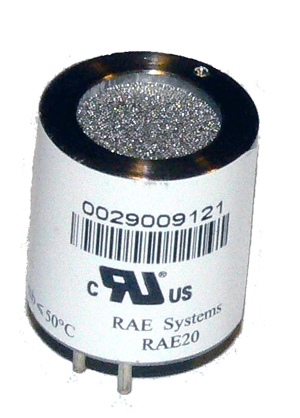
Gas Principles
Pellistor
Principle
 Pellistor is based on two thin platinum wires in aluminium beds connected to Wheatson bridge. One bed is covered with a special catalyst initiating oxidation of flammable gase (vapours), the other bed is modified to inhibit oxidation. The catalytic bed increases the temperature during the oxidation process in the presence of flammable gases (vapours). Oxidation process increases temperature of the bed with catalyst, which causes increase of resistance. The result of this status a bridge imbalance.
Pellistor is based on two thin platinum wires in aluminium beds connected to Wheatson bridge. One bed is covered with a special catalyst initiating oxidation of flammable gase (vapours), the other bed is modified to inhibit oxidation. The catalytic bed increases the temperature during the oxidation process in the presence of flammable gases (vapours). Oxidation process increases temperature of the bed with catalyst, which causes increase of resistance. The result of this status a bridge imbalance.
Benefits
- Linearn output up to 100% LEL
- Cheap and stable sensor
- Quick response time (< 10 s)
- Operation temperature: -40 to +60°C
Weaknesses
- Liable to poisoning and sensitivity decrease
- Required atmosphere with oxygen above 10% vol.
- Poisoned sensor gives output like sensor at zero concentration - requires regular span gas application
- Higher power consumption
Electrochemical
 Principle
Principle
Electrochemical sensor consists of 2, 3 or 4 electrodes, which are located in a gel electrolyte. A system of electrodes and the electrolyte is separated from the atmosphere by a diffusion barrier. Gas molecules diffuse through this barrier and react with the electrolyte. There are oxidation and reduction reactions at the electrodes and they cause a change of cell potential. The higher the gas concentration is, the higher the potential will be.
Benefits
- Reliable and non-expensive sensors for „common“ gases
Weaknesses
- Long response time (up to few minutes for some gases)
- Higher price for special gases
- Potential failure when exposed with high concentrations
- Cross interferences (ozone sensor is sensitive to air flow, temperature and humidity changes)
Photoionization detector
Principle
 A Photoionization detector (PID) uses an ultraviolet (UV) light source to ionize chemicals to positive and negative ions that can be easily counted with a detector. Ionization occurs when a molecule absorbs the light energy. The gas becomes electrically charged. These charged particles produce a current that is then amplified and displayed on the meter as "ppm" or even "ppb".
A Photoionization detector (PID) uses an ultraviolet (UV) light source to ionize chemicals to positive and negative ions that can be easily counted with a detector. Ionization occurs when a molecule absorbs the light energy. The gas becomes electrically charged. These charged particles produce a current that is then amplified and displayed on the meter as "ppm" or even "ppb".
Benefits
- modern type (3D) is not affected by temperature and humidity changes
- one detector can detect broad range of gases
- high sensitivity (ppb's)
- quick response (< 3 s)
- high precision at very low levels
Weaknesses
- low selectivity for most compounds
Infrared
Principle
A Infrared detector (IR) uses an ability of gases with two ore more atoms to absorb infrared (IR) light, e.g. carbon dioxide, methane. Infrared detectors use wavelengths specific corresponding to vibration or rotation of a bond between two atoms in the gas molecule. The higher gas concentration the lower IR signal (approx. logarithmic function).
Benefits
- Does not require oxygen for the measurement
- Impossible to damage by catalytic poisons
- DIrty optics warning
- Working up to 80% optics obscuration
- Good selectivity
Weaknesses
- Higher costs
TCD
 Principle
Principle
TC gas detectors, sometimes called Katharometers operate by comparing the thermal conductivity of the sample with that of a reference gas (usually air). A heated thermistor or platinum filament is mounted so that it is exposed to the sample and another, acting as a reference is enclosed in a sealed compartment.
If the sample has a higher thermal conductivity than the reference, heat is lost from the exposed element and its temperature decreases, whilst if the thermal conductivity is lower than that of the reference the temperature of the exposed element increases. These temperature changes cause electrical resistance changes, which are measured by means of a bridge circuit.
Because of the amount of power required to heat these sensors, they have to be mounted in a flameproof enclosure, in the same way as pellistors are. The precise mechanism, which occurs, is quite complex because the thermal conductivities of gases vary with temperature and convection as well as conductivity plays a role. Whilst most gases exhibit a linear output signal, this is not always the case.
Benefits
- Suitable for binary mixtures
- Fast response
Weaknesses
- Temperature dependent (long equilibration time)
- Inapplicable for more complex gas mixtures
- Gases with thermal conductivities of less than one are more difficult to measure, partly because water vapour may cause an interference problem
- Gases with thermal conductivities close to one cannot be measured (CO, O2, N2, NH3)
- Ukázat vše






QuEChERS Internal Std Mix for GC-NPD and LC-MS/MS Analysis, acetonitrile, 5ml
Dostupnost: na dotazNa dotaz
QuEChERS Internal Std Mix for GC/MS Analysis, 50µg/ml, Acetonitril, 5ml
Dostupnost: na dotazNa dotaz





 0
0
 0
0